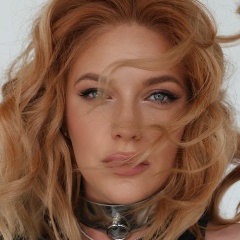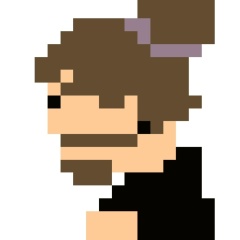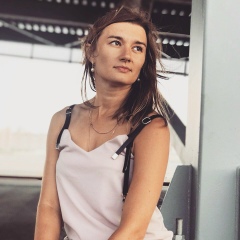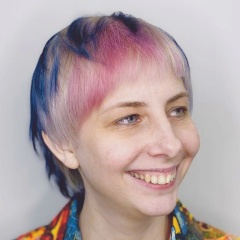Три способа войти в Ширшасану
Стойка на голове разгружает вены ног и таза, улучшает венозный и лимфатический отток от нижних конечностей и служит профилактикой варикоза и отёков.
Ширшасана нормализует работу эндокринной системы и устраняет нарушения в работе гипоталамо-гипофизарной оси.
Из-за притока крови к головному мозгу, Ширшасана снимает усталость, тонизирует и повышает концентрацию.
1) О̲д̲н̲о̲н̲о̲г̲и̲й̲ ̲в̲х̲о̲д̲ ̲в̲ ̲с̲т̲о̲й̲к̲у̲ ̲н̲а̲ ̲г̲о̲л̲о̲в̲е̲.̲ Этот способ – самый естественный для начинающих. Одну ногу отстраиваем в вертикальном положении и через неё тянемся вверх, а другой ногой догоняем первую.
Сложности. Если не хватает растяжки, сразу до вертикали ногу поднять не получится – приходится отталкиваться от пола и прыгать в позу. Любые резкие движения – в том числе, прыжки, — делают асану нестабильной. Чтобы убрать прыжок и войти в Ширшасану плавно, ноги можно поставить на блок для йоги, стену или стул – и стартовать из более высокого положения.
Вторая сложность одноногого входа в стойку на голове – с другой ноги отстраивать Ширшасану становится неудобно. Мышцы ног работают по-разному: одна нога более растянута, другая – толчковая — более сильная. Из-за дисбаланса в работе ног неравномерно работают мышцы пресса и спины справа и слева. Поэтому для профилактики перекосов таза и искривлений позвоночника важно отрабатывать вход в стойку на голове и с удобной, и с неудобной ноги.
2) В̲х̲о̲д̲ ̲в̲ ̲Ш̲и̲р̲ш̲а̲с̲а̲н̲у̲ ̲с̲о̲ ̲с̲к̲о̲л̲ь̲ж̲е̲н̲и̲е̲м̲.̲ Хороший вариант для равномерной работы ног, спины и пресса слева и справа. Вход в стойку на голове со скольжением выполняем прямо на полу, подстелив под стопы плед – ноги должны скользить. Вместо прыжка используем инерцию. Три раза скользим ногами назад-вперёд из позы Дельфина. После очередного скольжения вперёд позволяем ногам подняться.
Во время скольжения в позе Дельфина важно почувствовать, как работает пресс, научиться группироваться. Когда поднимаем ноги, пресс остаётся сильным. Так мы стабилизируем таз и не завалимся назад.
3) В̲х̲о̲д̲ ̲в̲ ̲с̲т̲о̲й̲к̲у̲ ̲н̲а̲ ̲г̲о̲л̲о̲в̲е̲ ̲п̲е̲р̲е̲н̲о̲с̲о̲м̲ ̲в̲е̲с̲а̲.̲ Способ похож на предыдущий, но мы не используем вспомогательные материалы и движения. Чтобы всё получилось, нужны сильные спина и пресс.
Важно входить в стойку медленно и контролировать наклон корпуса. Пока ноги ниже горизонта, корпус заваливается назад. А когда ноги выше таза, нужно возвращать корпус к вертикали. В конечном положении таз – на одной линии с головой и стопами.
Какой бы вариант Ширшасаны мы ни практиковали, не забываем, что основная часть веса – на руках. Руками отжимаемся от пола и выталкиваем себя вверх — разгружаем шею, насколько можем.
Для более стабильной стойки на голове локтями стягиваем коврик к центру и уводим вес в локти – сильнее давим ими в пол.
О замене Ширшасаны при проблемах шеи и о противопоказаниях к выполнению стойки на голове я писала здесь: http://www.yogalike.ru/lichnaya-praktika-blogi/shirshasana-bez-davleniya-na-sheyu/.
Стойка на голове разгружает вены ног и таза, улучшает венозный и лимфатический отток от нижних конечностей и служит профилактикой варикоза и отёков.
Ширшасана нормализует работу эндокринной системы и устраняет нарушения в работе гипоталамо-гипофизарной оси.
Из-за притока крови к головному мозгу, Ширшасана снимает усталость, тонизирует и повышает концентрацию.
1) О̲д̲н̲о̲н̲о̲г̲и̲й̲ ̲в̲х̲о̲д̲ ̲в̲ ̲с̲т̲о̲й̲к̲у̲ ̲н̲а̲ ̲г̲о̲л̲о̲в̲е̲.̲ Этот способ – самый естественный для начинающих. Одну ногу отстраиваем в вертикальном положении и через неё тянемся вверх, а другой ногой догоняем первую.
Сложности. Если не хватает растяжки, сразу до вертикали ногу поднять не получится – приходится отталкиваться от пола и прыгать в позу. Любые резкие движения – в том числе, прыжки, — делают асану нестабильной. Чтобы убрать прыжок и войти в Ширшасану плавно, ноги можно поставить на блок для йоги, стену или стул – и стартовать из более высокого положения.
Вторая сложность одноногого входа в стойку на голове – с другой ноги отстраивать Ширшасану становится неудобно. Мышцы ног работают по-разному: одна нога более растянута, другая – толчковая — более сильная. Из-за дисбаланса в работе ног неравномерно работают мышцы пресса и спины справа и слева. Поэтому для профилактики перекосов таза и искривлений позвоночника важно отрабатывать вход в стойку на голове и с удобной, и с неудобной ноги.
2) В̲х̲о̲д̲ ̲в̲ ̲Ш̲и̲р̲ш̲а̲с̲а̲н̲у̲ ̲с̲о̲ ̲с̲к̲о̲л̲ь̲ж̲е̲н̲и̲е̲м̲.̲ Хороший вариант для равномерной работы ног, спины и пресса слева и справа. Вход в стойку на голове со скольжением выполняем прямо на полу, подстелив под стопы плед – ноги должны скользить. Вместо прыжка используем инерцию. Три раза скользим ногами назад-вперёд из позы Дельфина. После очередного скольжения вперёд позволяем ногам подняться.
Во время скольжения в позе Дельфина важно почувствовать, как работает пресс, научиться группироваться. Когда поднимаем ноги, пресс остаётся сильным. Так мы стабилизируем таз и не завалимся назад.
3) В̲х̲о̲д̲ ̲в̲ ̲с̲т̲о̲й̲к̲у̲ ̲н̲а̲ ̲г̲о̲л̲о̲в̲е̲ ̲п̲е̲р̲е̲н̲о̲с̲о̲м̲ ̲в̲е̲с̲а̲.̲ Способ похож на предыдущий, но мы не используем вспомогательные материалы и движения. Чтобы всё получилось, нужны сильные спина и пресс.
Важно входить в стойку медленно и контролировать наклон корпуса. Пока ноги ниже горизонта, корпус заваливается назад. А когда ноги выше таза, нужно возвращать корпус к вертикали. В конечном положении таз – на одной линии с головой и стопами.
Какой бы вариант Ширшасаны мы ни практиковали, не забываем, что основная часть веса – на руках. Руками отжимаемся от пола и выталкиваем себя вверх — разгружаем шею, насколько можем.
Для более стабильной стойки на голове локтями стягиваем коврик к центру и уводим вес в локти – сильнее давим ими в пол.
О замене Ширшасаны при проблемах шеи и о противопоказаниях к выполнению стойки на голове я писала здесь: http://www.yogalike.ru/lichnaya-praktika-blogi/shirshasana-bez-davleniya-na-sheyu/.
Three Ways to Enter Shirshasana
The headstand relieves the veins of the legs and pelvis, improves venous and lymphatic drainage from the lower extremities and serves as a prevention of varicose veins and edema.
Shirshasana normalizes the endocrine system and eliminates disturbances in the hypothalamic-pituitary axis.
Due to the flow of blood to the brain, Shirshasana relieves fatigue, tones and increases concentration.
1) O̲̲̲̲̲̲̲̲̲̲̲̲̲̲̲̲̲̲̲̲̲̲̲̲̲̲̲̲̲̲̲̲̲̲̲̲̲̲̲̲̲̲̲̲̲̲̲̲̲ This method is the most natural for beginners. We rebuild one leg in an upright position and stretch upward through it, and catch the first with the other leg.
Difficulties. If there is not enough stretching, you won’t be able to raise your leg right up to the vertical - you have to push off from the floor and jump into a pose. Any sudden movements, including jumping, make the asana unstable. To remove the jump and enter Shirshasana smoothly, you can put your feet on a yoga block, wall or chair - and start from a higher position.
The second difficulty of the one-legged entrance to the headstand - it is inconvenient to rebuild Shirshasana from the other leg. The leg muscles work in different ways: one leg is more stretched, the other - jogging - is stronger. Due to the imbalance in the legs, the abs and back muscles work unevenly on the right and left. Therefore, for the prevention of pelvic distortions and curvature of the spine, it is important to work out the entrance to the headstand with both comfortable and uncomfortable legs.
2) В̲х̲о̲д̲ ̲в̲ ̲Ш̲и̲р̲ш̲а̲с̲а̲н̲у̲ ̲с̲о̲ ̲с̲к̲о̲л̲ь̲ж̲е̲н̲и̲е̲м̲.̲ A good option for uniform work of the legs, back and abs left and right. We enter the headstand with sliding right on the floor, laying a plaid under the feet - the legs should slide. Instead of jumping, we use inertia. Three times we slide our legs back and forth from the Dolphin pose. After another glide forward, let the legs rise.
While sliding in the Dolphin pose, it is important to feel how the press works, to learn how to group. When we raise our legs, the abs remains strong. So we stabilize the pelvis and do not fall back.
3) В̲х̲о̲д̲ ̲в̲ ̲с̲т̲о̲й̲к̲у̲ ̲н̲а̲ ̲г̲о̲л̲о̲в̲е̲ ̲п̲е̲р̲е̲н̲о̲с̲о̲м̲ ̲в̲е̲с̲а̲.̲ The method is similar to the previous one, but we do not use auxiliary materials and movements. For everything to work out, you need a strong back and abs.
It is important to enter the rack slowly and control the tilt of the chassis. While the legs are below the horizon, the body falls back. And when the legs are above the pelvis, you need to return the body to the vertical. In the final position, the pelvis is in line with the head and feet.
Whatever version of Shirshasana we practice, we do not forget that the bulk of the weight is on hand. With our hands we push ourselves from the floor and push ourselves up - we unload the neck as far as we can.
For a more stable headstand with elbows we pull the mat to the center and remove the weight to the elbows - we push them harder on the floor.
I wrote about replacing Shirshasana with neck problems and about contraindications for performing a headstand here: http://www.yogalike.ru/lichnaya-praktika-blogi/shirshasana-bez-davleniya-na-sheyu/.
The headstand relieves the veins of the legs and pelvis, improves venous and lymphatic drainage from the lower extremities and serves as a prevention of varicose veins and edema.
Shirshasana normalizes the endocrine system and eliminates disturbances in the hypothalamic-pituitary axis.
Due to the flow of blood to the brain, Shirshasana relieves fatigue, tones and increases concentration.
1) O̲̲̲̲̲̲̲̲̲̲̲̲̲̲̲̲̲̲̲̲̲̲̲̲̲̲̲̲̲̲̲̲̲̲̲̲̲̲̲̲̲̲̲̲̲̲̲̲̲ This method is the most natural for beginners. We rebuild one leg in an upright position and stretch upward through it, and catch the first with the other leg.
Difficulties. If there is not enough stretching, you won’t be able to raise your leg right up to the vertical - you have to push off from the floor and jump into a pose. Any sudden movements, including jumping, make the asana unstable. To remove the jump and enter Shirshasana smoothly, you can put your feet on a yoga block, wall or chair - and start from a higher position.
The second difficulty of the one-legged entrance to the headstand - it is inconvenient to rebuild Shirshasana from the other leg. The leg muscles work in different ways: one leg is more stretched, the other - jogging - is stronger. Due to the imbalance in the legs, the abs and back muscles work unevenly on the right and left. Therefore, for the prevention of pelvic distortions and curvature of the spine, it is important to work out the entrance to the headstand with both comfortable and uncomfortable legs.
2) В̲х̲о̲д̲ ̲в̲ ̲Ш̲и̲р̲ш̲а̲с̲а̲н̲у̲ ̲с̲о̲ ̲с̲к̲о̲л̲ь̲ж̲е̲н̲и̲е̲м̲.̲ A good option for uniform work of the legs, back and abs left and right. We enter the headstand with sliding right on the floor, laying a plaid under the feet - the legs should slide. Instead of jumping, we use inertia. Three times we slide our legs back and forth from the Dolphin pose. After another glide forward, let the legs rise.
While sliding in the Dolphin pose, it is important to feel how the press works, to learn how to group. When we raise our legs, the abs remains strong. So we stabilize the pelvis and do not fall back.
3) В̲х̲о̲д̲ ̲в̲ ̲с̲т̲о̲й̲к̲у̲ ̲н̲а̲ ̲г̲о̲л̲о̲в̲е̲ ̲п̲е̲р̲е̲н̲о̲с̲о̲м̲ ̲в̲е̲с̲а̲.̲ The method is similar to the previous one, but we do not use auxiliary materials and movements. For everything to work out, you need a strong back and abs.
It is important to enter the rack slowly and control the tilt of the chassis. While the legs are below the horizon, the body falls back. And when the legs are above the pelvis, you need to return the body to the vertical. In the final position, the pelvis is in line with the head and feet.
Whatever version of Shirshasana we practice, we do not forget that the bulk of the weight is on hand. With our hands we push ourselves from the floor and push ourselves up - we unload the neck as far as we can.
For a more stable headstand with elbows we pull the mat to the center and remove the weight to the elbows - we push them harder on the floor.
I wrote about replacing Shirshasana with neck problems and about contraindications for performing a headstand here: http://www.yogalike.ru/lichnaya-praktika-blogi/shirshasana-bez-davleniya-na-sheyu/.
У записи 1 лайков,
1 репостов,
69 просмотров.
1 репостов,
69 просмотров.
Эту запись оставил(а) на своей стене Ольга Гончарова






















